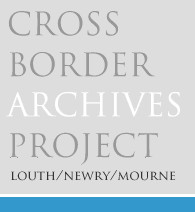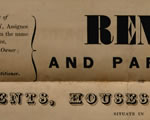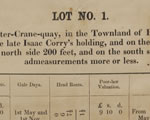Incumbered Estates Court
A Glimpse of the Past
Exhibition image seven shows the cover of a sales catalogue produced for the sale of the estate of James Scott Molloy and others, under direction of the Incumbered Estates Court in 1851. Up for auction are a number of tenements, houses and premises in counties Down and Armagh, with a total rental income of over £145.
As image eight illustrates, information commonly provided in sale catalogues includes Tenants' Name, Description of Holding, Yearly Rents, Gale Days, Head Rents, Poor-law Valuation, Tenants' Tenure and Observations. For example, it is recorded that John Anderson is presently holding tenement No. 6, Buttercrane Quay, at cost of £55 per year with a Poor-law valuation of £50. The holding is described as a 'dwelling-house, yard, and offices, late a brewery'.
Financial Distress
The surviving sources in the Reside Collection shed little light on why those estates found themselves in the Court of the Commissioners for Sale of Incumbered Estates in Ireland. Yet the reasons for financial distress may lie in one or a combination of fiscal difficulties that plagued estate owners during the middle nineteenth century and beyond. These included rent arrears accumulated during the Great Famine, estate charges and annuities, debt, living costs, and the upkeep and maintenance of buildings and property.
Documentary evidence no longer survives to allow examination of accounts or financial transactions relating to the above insolvent estates. Of those causes most commonly advanced for estate bankruptcy, the onset of the Great Famine in Ireland during the period 1845 to 1849, is perhaps of greatest significance. A review of rental records for Lord Kilmorey's Newry Estate in the Reside Collection for the years of the Great Famine, reveals arrears on holdings increasing from more than £398 by November 1846 to over £677 for the same period in 1850.
It is important to note, however, that rental arrears were a quite persistent part of estate life, and even by the end of November 1843, money owing by the Kilmorey tenantry totalled more than £159. From such rental records, a glimpse is afforded of the reasons behind the depletion of rent receipts; namely impoverishment, death, emigration and eviction. Even though it is recognized that county Down withstood the ravishes of famine better than many other Irish counties, it must be made clear that accumulated rental arrears struck a very harsh blow to the heart of estate income.
Next page - Family Obligations » « Previous page - The Big House
- home |
- about project |
- online catalogue |
- online exhibitions |
- activities |
- oral history collection
- about us |
- contact us |
- legal |
- acknowledgements
© Cross Border Archives Project . Website design and development by morsolutions.
This project is part financed by the European Union through the Interreg IIIA Programme managed for the Special EU Programmes Body by the East Border Region Interreg IIIA Partnership.






